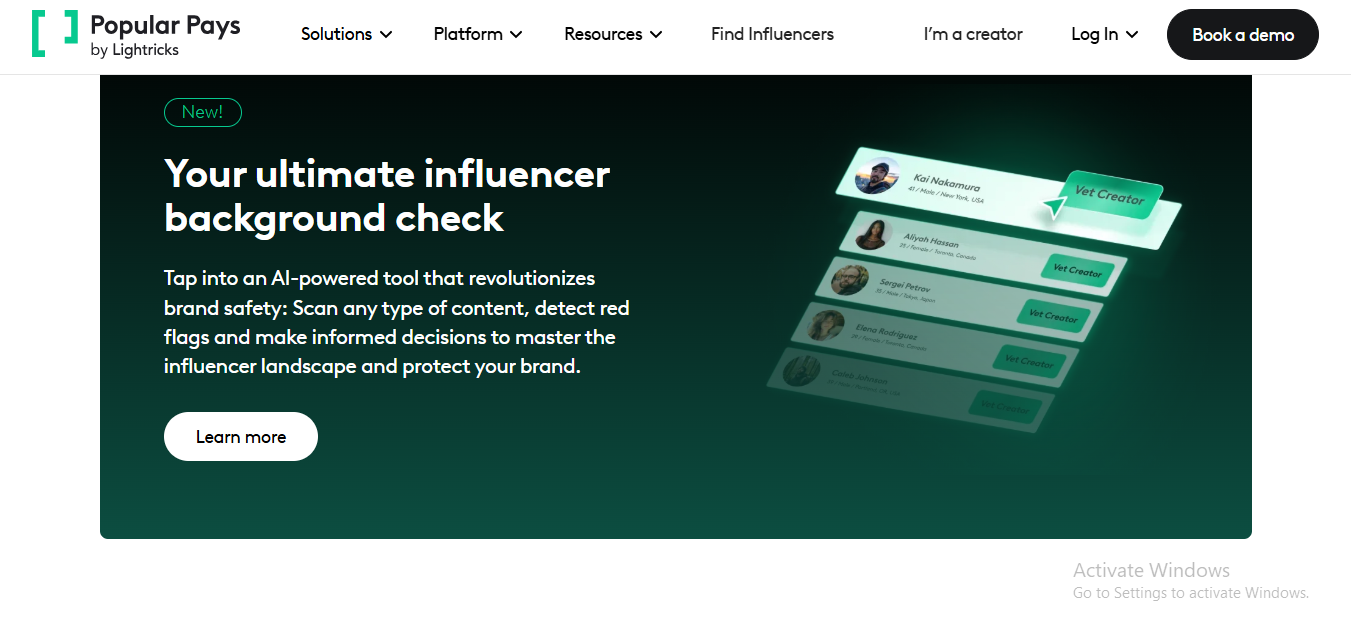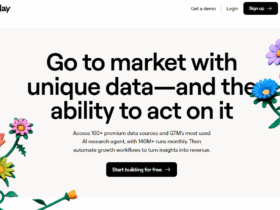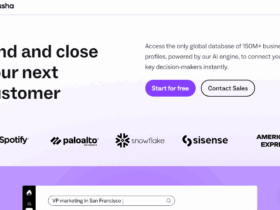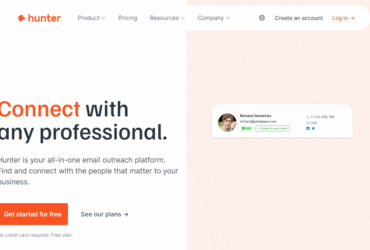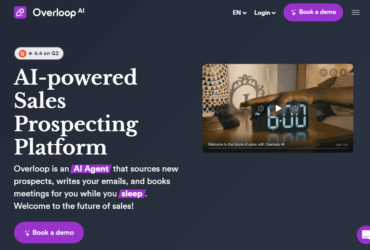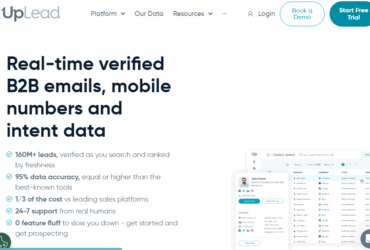lright besties, let’s talk real for a sec. If you’ve been riding the Popular Pays train and feel like the vibes are kinda… off lately, you’re not alone. It had its glow-up moment, don’t get me wrong, but with 2025 knocking and influencer marketing evolving faster than TikTok trends, it might be time to explore some juicier, smarter, and way more feature-packed alternatives.
I rolled up my sleeves, signed up for all the platforms your fave brands are secretly using, and did a full-on comparison binge so you don’t have to. I’m talking pros, cons, features, and yes—whether the price tag is giving “worth it” or “absolutely not.”
1. Mavrck

Mavrck is like the Beyoncé of influencer platforms—polished, powerful, and totally running the show behind the scenes. It’s built for big brands who want everything from micro to macro, UGC to affiliate, and a bunch more acronyms I won’t bore you with.
What I Loved:
-
All-in-one platform with campaign building, recruiting, UGC collection, and even loyalty programs.
-
Crazy good analytics dashboard—like, “Wow, this makes me look like I know what I’m doing” good.
-
Auto-identifies influencers from your own customer base (hello, genius idea 👏).
What I Didn’t:
-
It’s clearly made for enterprise budgets, not broke startups.
-
Takes some onboarding time. Not exactly plug-n-play.
Pricing:
-
$$$$ – For the big players. Think: Fortune 500 vibes.
Vibe Check:
For brands with budget and big influencer energy. Not DIY-friendly, but once it’s set up? Chef’s kiss.
2. The Influencer Room
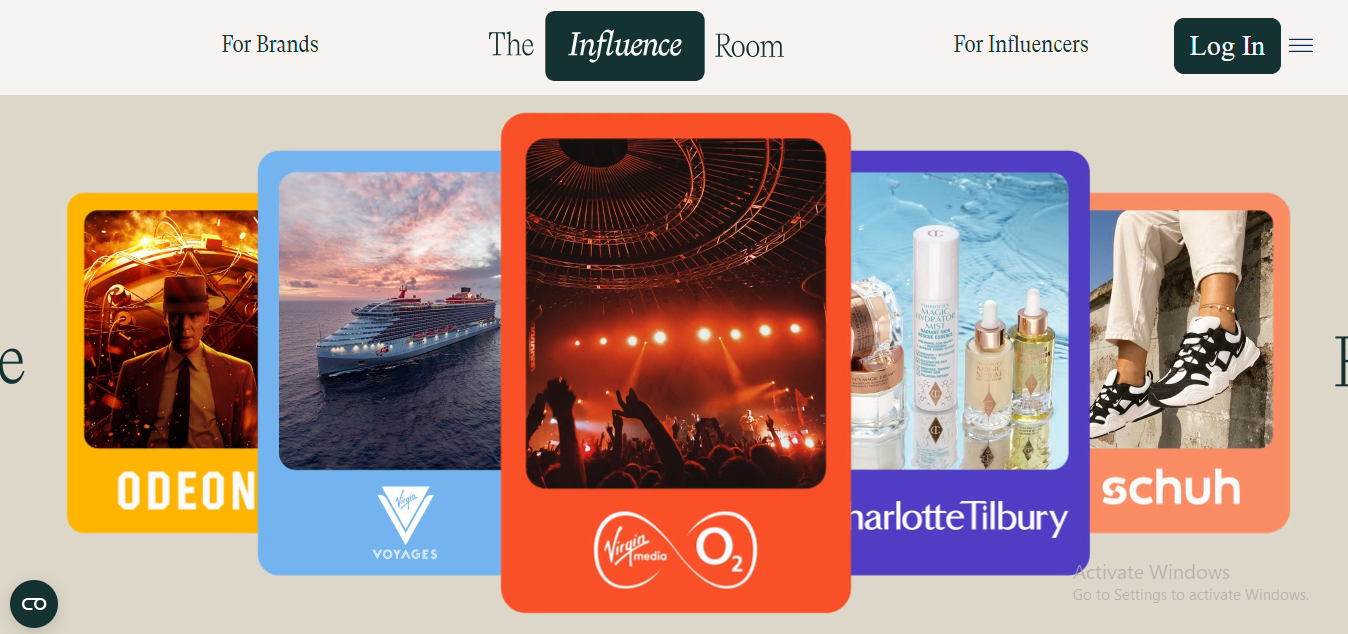
Okay, this one’s got personality. The Influencer Room flips the script by focusing on relationships over transactions. Think matchmaking, but make it brand collabs.
What I Loved:
-
Invite-only vibe makes it feel exclusive AF.
-
Influencers apply to work with you, not the other way around. Um, power move?
-
Focused on building actual partnerships, not just one-off gigs.
What I Didn’t:
-
Limited reach if you’re looking for mass campaigns or huge influencer databases.
-
More vibes-based than metrics-based. Not for the ROI-hungry.
Pricing:
-
$$$ – Mid-to-high range. You’re paying for the intimacy.
Vibe Check:
For premium brands who want deeper influencer bonds, not just another #spon deal.
3. GRIN
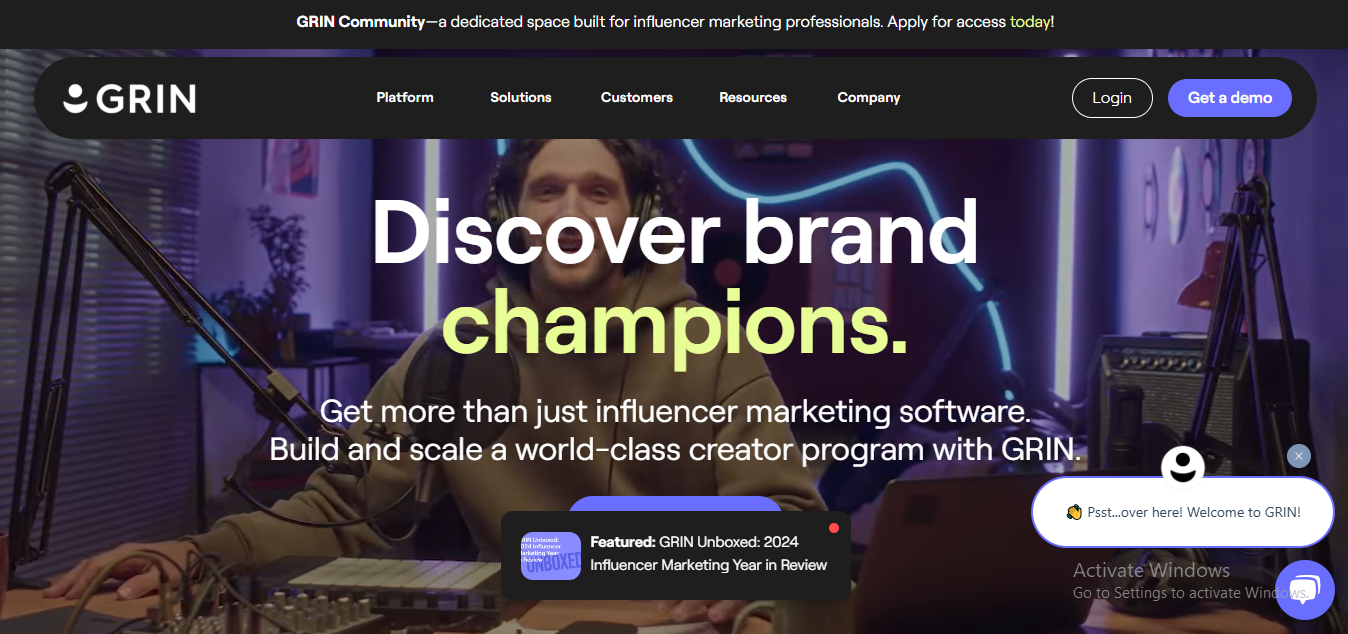
GRIN is like the tech bro of influencer platforms—nerdy, clean, and quietly flexing under the radar. It’s eCommerce-friendly and obsessed with integrations. Shopify who? You’re gonna want this plugged in.
What I Loved:
-
Direct-to-influencer management—no middlemen.
-
Full CRM system for creators. You get to treat them like your fave clients.
-
Built-in affiliate tools and product seeding workflows.
What I Didn’t:
-
UI isn’t super fun. Feels a bit like managing spreadsheets in Silicon Valley.
-
Not the easiest setup if you’re not tech-savvy.
Pricing:
-
$$$ – Not cheap, but you do get a lot of automation tools.
Vibe Check:
For eComm brands who live and breathe integrations and want control over every touchpoint.
4. Influencity
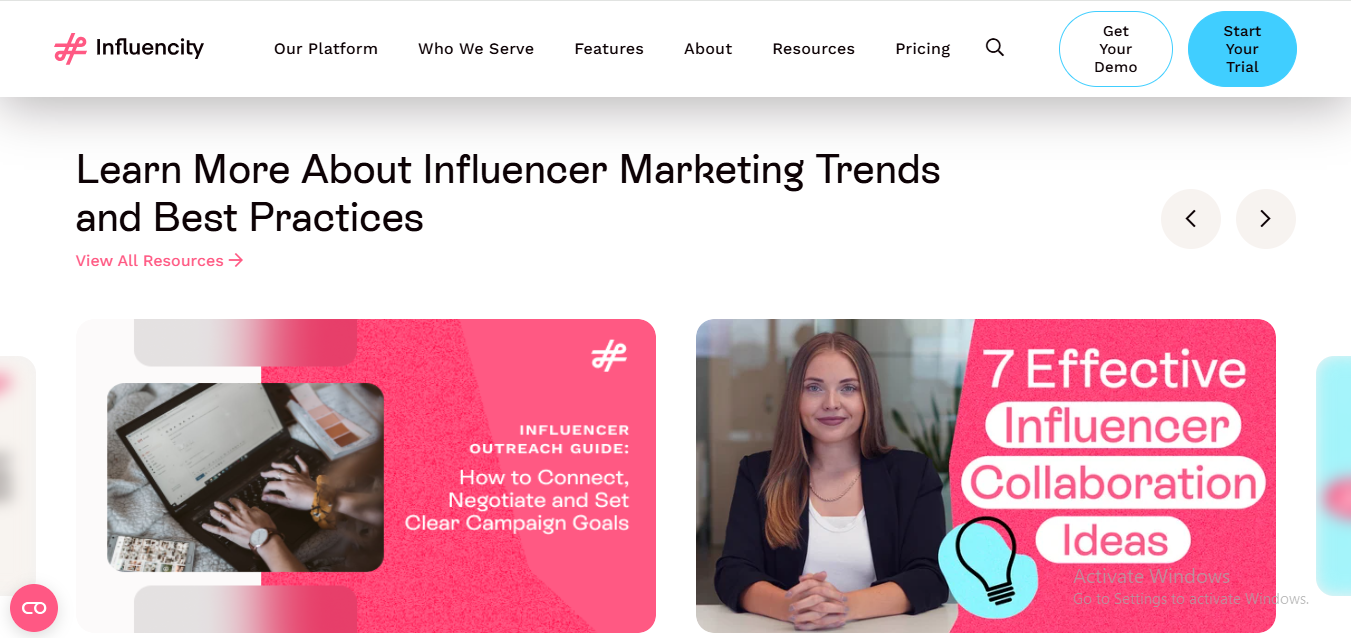
Okay, this one caught me off guard. Influencity is a data monster (in a good way), and it’s perfect for marketers who want results over fluff. It’s low-key becoming the underdog success story of 2025.
What I Loved:
-
Real-time influencer data and audience breakdowns.
-
Powerful search filters. Like, “I want a London-based dog mom with 3% engagement and mostly Gen Z followers” level specific.
-
Campaign tracking that actually makes sense.
What I Didn’t:
-
The UX/UI isn’t super
sexy. -
Support is decent, but not wow.
Pricing:
-
$$ – Honestly affordable for what you get.
Vibe Check:
For data-driven teams who love stats more than selfies. Also great for global campaigns.
5. Hashtag Paid
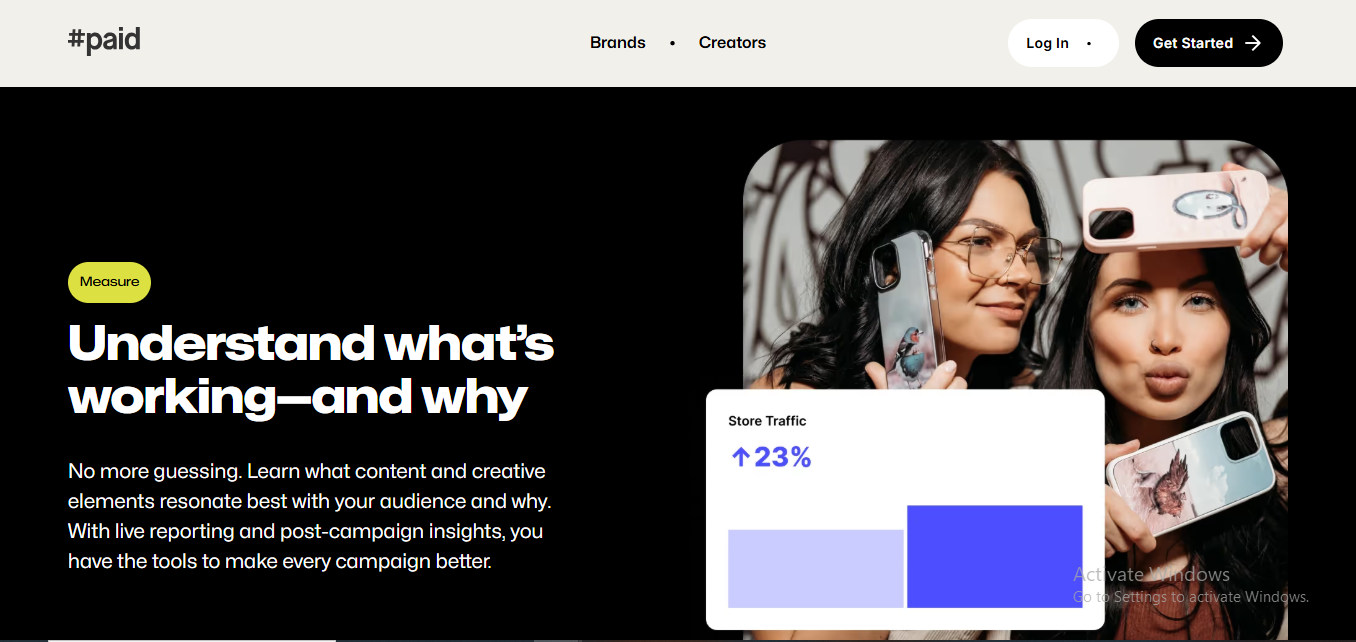
Ugh, I love this one. #paid has major cool kid energy. The UI is clean, it’s got vibes, and it knows what it’s doing when it comes to matching brands with creators who actually fit.
What I Loved:
-
Handraise feature – influencers ask to work with you. Yes, flip the power.
-
No messy negotiations—creators come with pricing already set.
-
Amazing UI. Felt like using Netflix for influencer marketing.
What I Didn’t:
-
The campaign setup can feel a bit templated if you’re looking to do something super unique.
-
Higher-tier pricing if you want all the features.
Pricing:
-
$$$ – Medium to high depending on your needs.
Vibe Check:
For brands who want creator chemistry and slick processes without corporate blah.
6. Lolly
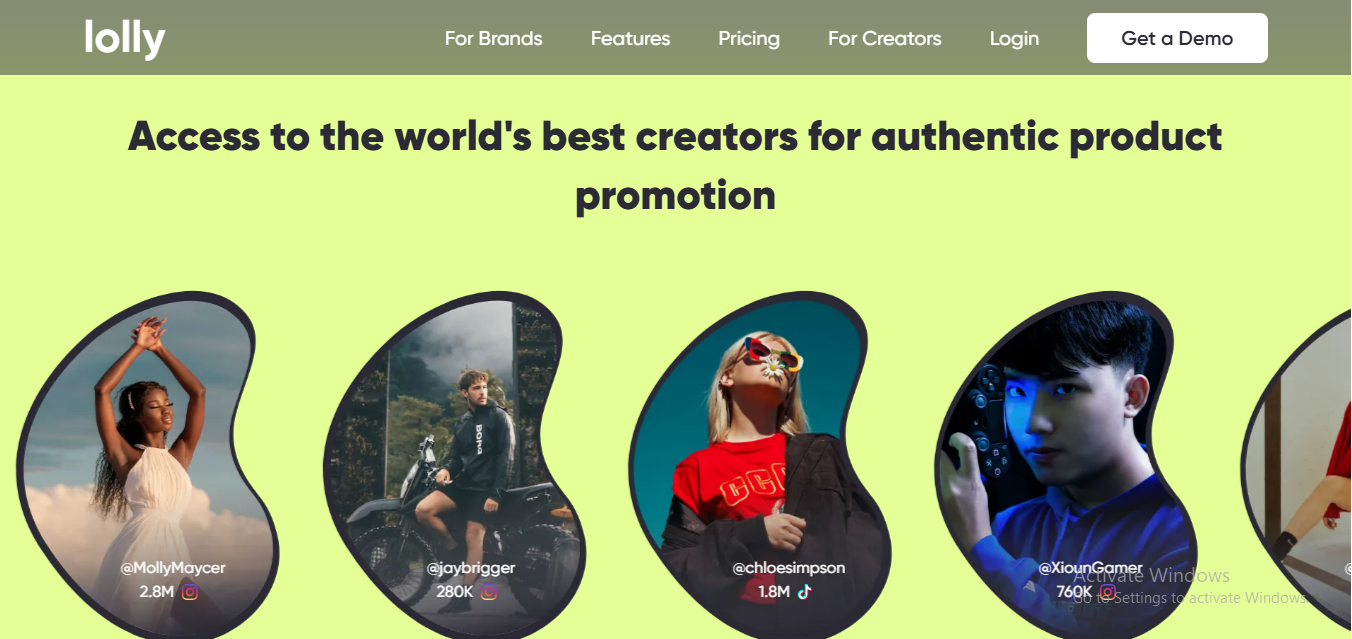
Lolly is the TikTok-core little sibling in the group. It’s fresh, it’s short-form obsessed, and it’s made for Gen Z-style content. If you’re trying to go viral or live in the land of UGC, this is your playground.
What I Loved:
-
Short-form content focus—they GET TikTok, Reels, Shorts.
-
Easy-peasy matching system with content-first creators.
-
Strong in entertainment, fashion, food, and beauty niches.
What I Didn’t:
-
Not much backend reporting—very content-centric, less analytics.
-
Still kinda growing, so not as robust as others yet.
Pricing:
-
$–$$ – Budget-friendly! A nice lil starter for small brands.
Vibe Check:
For brands who live on TikTok and want fast, fun content made by Gen Z.
7. The Cirqle
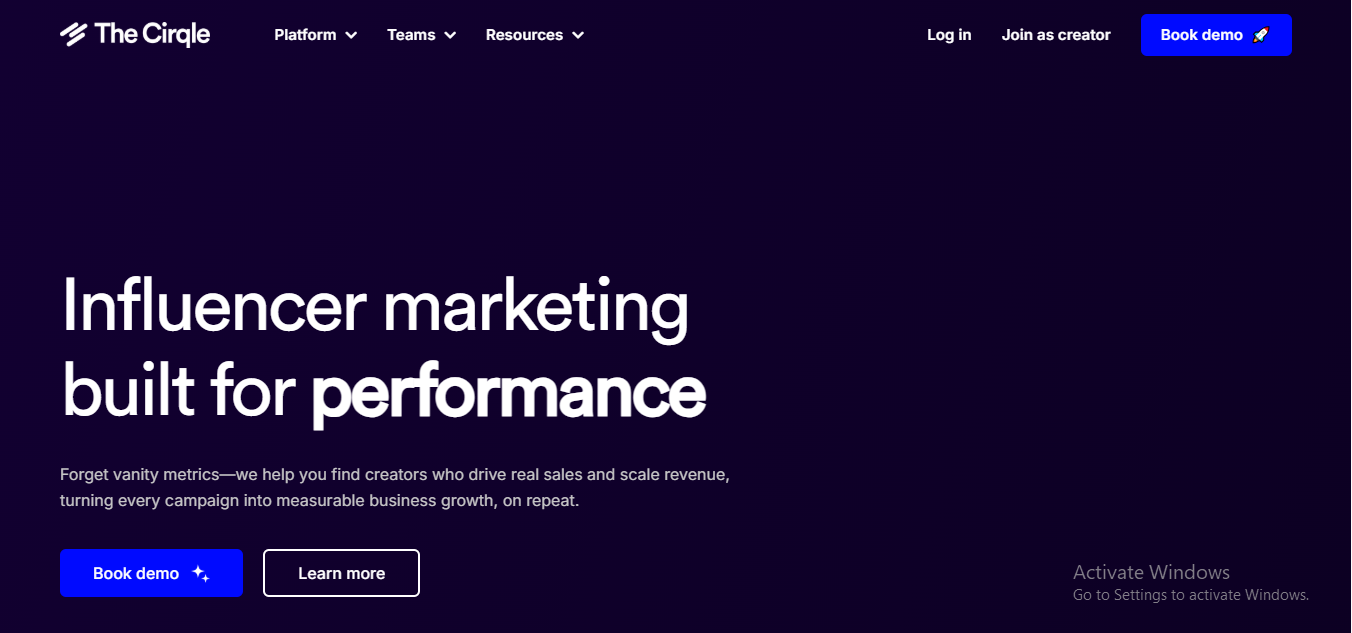
Okay, The Cirqle lowkey blew my mind. This one’s built for brands who want some serious global reach and data-driven influencer campaigns. We’re talking AI-infused magic meets sleek campaign tools.
What I Liked
-
Super slick UI – felt like I was using the iPhone of influencer platforms.
-
Their real-time ROI calculator? 👏 Bless. It’s like having a mini CMO in your dashboard.
-
Global creator reach, including micro and nano influencers.
What I Didn’t Love
-
Bit of a learning curve at first, ngl.
-
More tailored for mid-to-large brands, so if you’re just starting out, might be overkill.
Pricing
On the higher end—think enterprise-level pricing. Not super transparent upfront, so you’ll need to hop on a call.
Best For: Data-obsessed marketers and large brands who wanna run high-ROI campaigns globally.
8. Aspire (formerly AspireIQ)
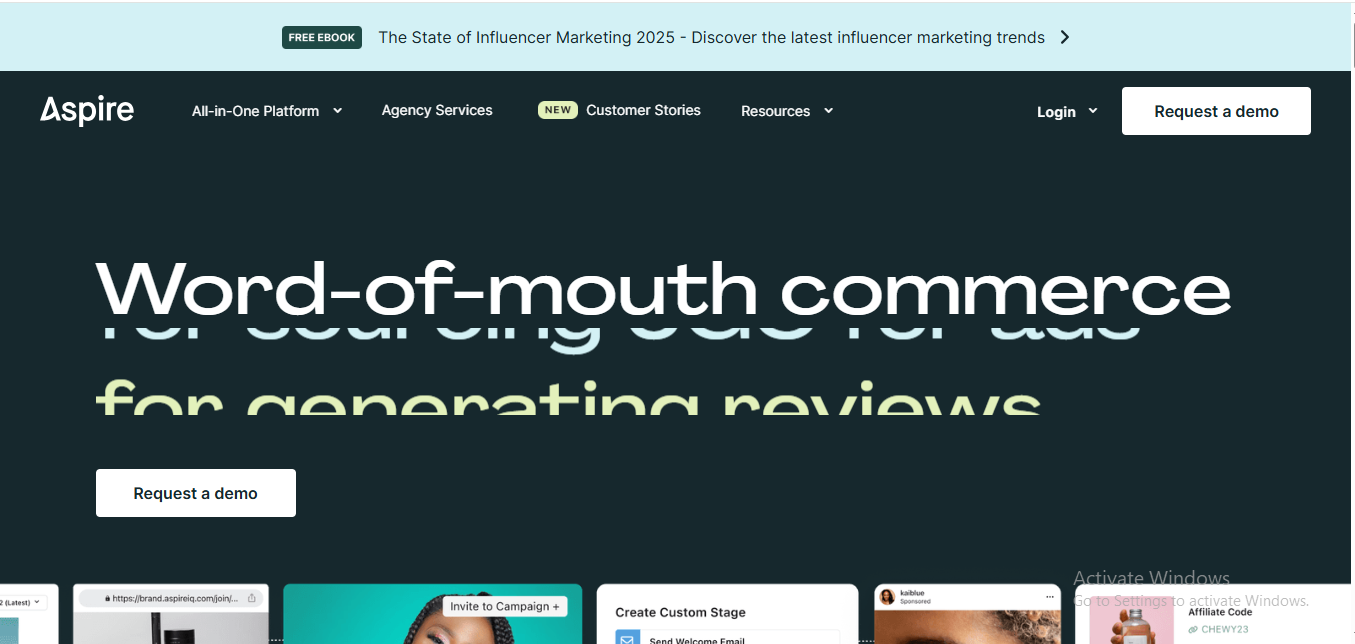
Aspire’s the cool kid who’s also super organized. If you like having everything in one place—collabs, tracking, payments, UGC—it’s like the Marie Kondo of influencer platforms.
What I Liked
-
You can manage ambassador programs and UGC campaigns together.
-
Loved the creator marketplace—easy to search, filter, and slide into DMs.
-
Built-in CRM vibes for keeping track of your fave influencers.
What I Didn’t Love
-
Campaign setup took a hot minute—it’s powerful, but there’s a lot going on.
-
Analytics are solid, but not as deep as some of the others.
Pricing
Starts around $1,200/month. Definitely not for hobbyists, but manageable for brands ready to scale.
Best For: DTC brands with an eye on building long-term influencer relationships.
9. Collabstr
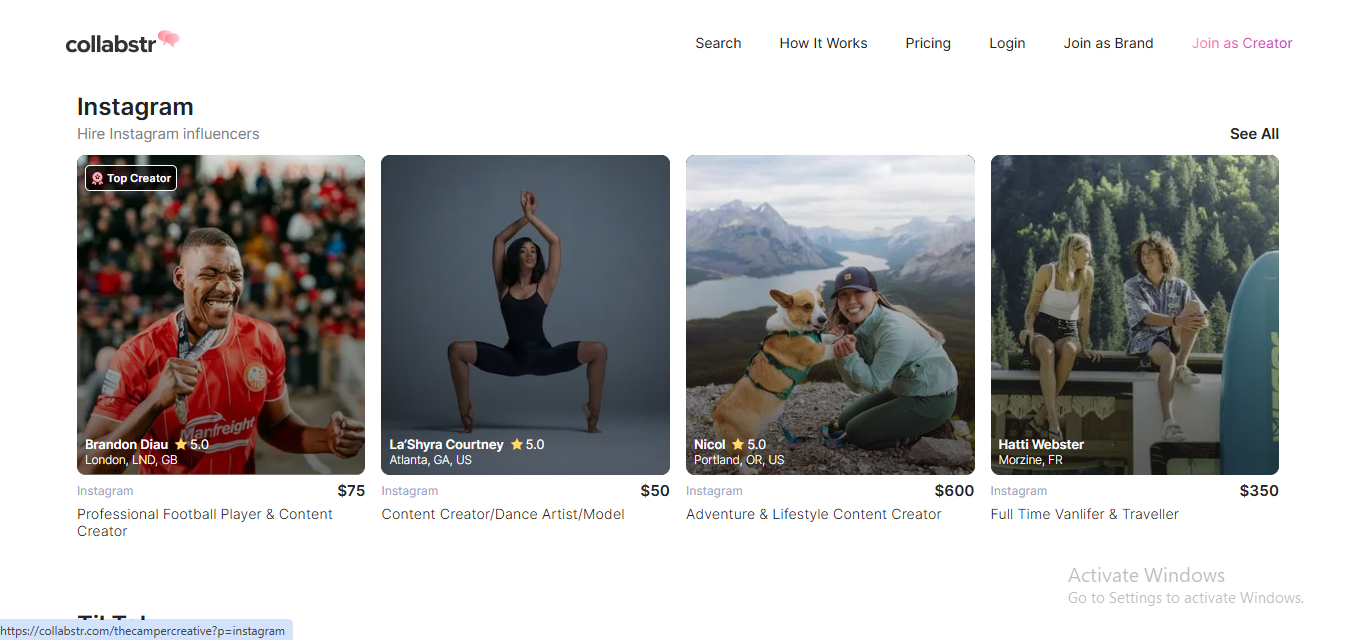
If you love the vibe of ordering tacos from a food truck, you’ll love Collabstr. It’s simple, fast, and straight to the point. Creators list their services, brands browse, and boom—collab made.
What I Liked
-
Instant collabs—like ordering content off a menu. Fast AF.
-
Prices are listed upfront! No guessing games.
-
No monthly fee. Pay as you go.
What I Didn’t Love
-
Not ideal for complex or large-scale campaigns.
-
Quality of creators can vary—do your homework before committing.
Pricing
Pay per collab. Expect $100–$1,000+ per influencer depending on their package.
Best For: Small brands, one-off campaigns, or anyone who loves a Tinder-style influencer experience.
10. Captiv8

This platform’s the Iron Man suit of influencer marketing. AI-powered matching, deep analytics, influencer fraud detection—it’s a whole tech stack in one place.
What I Liked
-
Influencer fraud detection (yes please).
-
Cross-platform tracking including TikTok, YouTube, and Insta.
-
You can customize just about everything—filters, reports, dashboards.
What I Didn’t Love
-
Honestly, it felt a bit too “corporate” for smaller users.
-
Takes time to onboard—this is not a plug-and-play type tool.
Pricing
Custom pricing only. Translation: Get ready for a sales call.
Best For: Enterprise brands and agencies who want to play big with AI and automation.
11. Kolsquare

French sophistication meets influencer marketing. This one’s more popular in Europe, but it’s creeping into the global scene—and for good reason.
What I Liked
-
Deep influencer analytics—audience authenticity, brand affinity, engagement trends.
-
Sweet multi-language support.
-
B2B-focused, so the tools are tailored for serious marketers.
What I Didn’t Love
-
Navigation was a little clunky compared to slicker UIs.
-
Smaller U.S. creator pool (for now).
Pricing
Starts around €600–€1,000/month, depending on your features.
Best For: Euro-based brands or global teams who want next-level influencer insights.
12. Popular Pays (Benchmark)
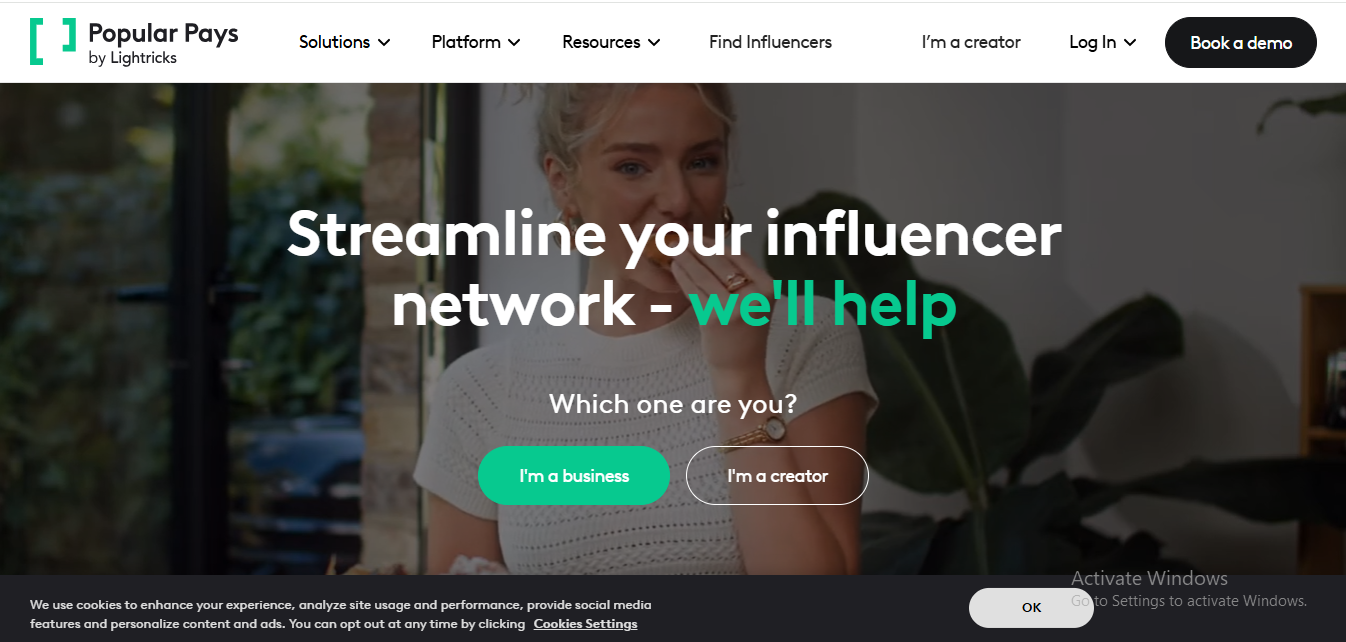
Just to throw it in for reference—Popular Pays is the OG most of y’all probably came from. It’s good for UGC, video content, and testing creative at scale.
What I Like
-
Excellent for UGC production and testing ads.
-
Solid creator database with a focus on content quality.
What I Don’t Like
-
Interface is starting to feel a lil’ dated.
-
Limited global reach compared to newer players.
Best For: Content-heavy campaigns and creative testing.
13. TRIBE
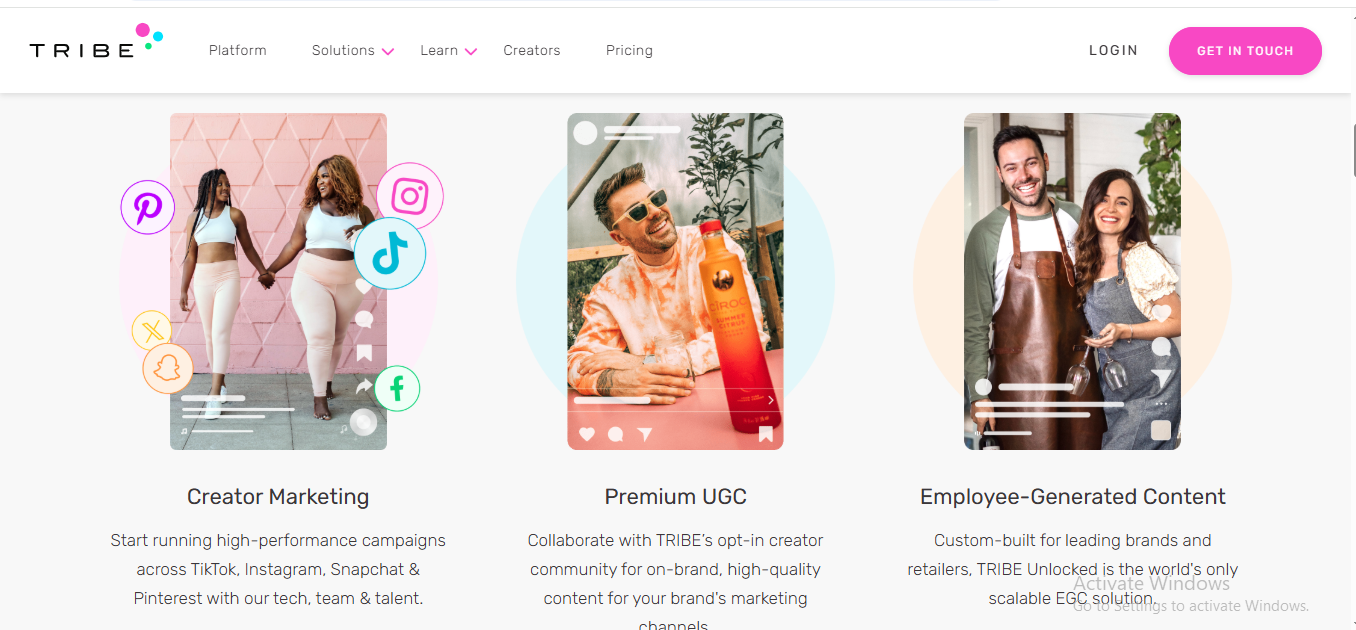
TRIBE is like the Airbnb of influencer collabs. Brands post a brief, creators pitch their content, and if you vibe with it—you buy it. Boom. It’s got major DIY energy.
What I Liked
-
Creator-first vibes. Influencers pitch content before you commit? Love that.
-
No subscriptions. You pay per piece, which is great for one-off campaigns or testing.
-
Fast turnaround on UGC—great for social ads or last-minute posts.
What I Didn’t Love
-
Can get pricey if you’re buying a ton of content.
-
No deep influencer search—it’s more reactive than proactive.
Pricing
Free to join, then you pay per piece of content—usually $100–$1,200 per post depending on the creator.
Best For: Brands looking for quick, quality UGC without a long-term contract.
14. Braze
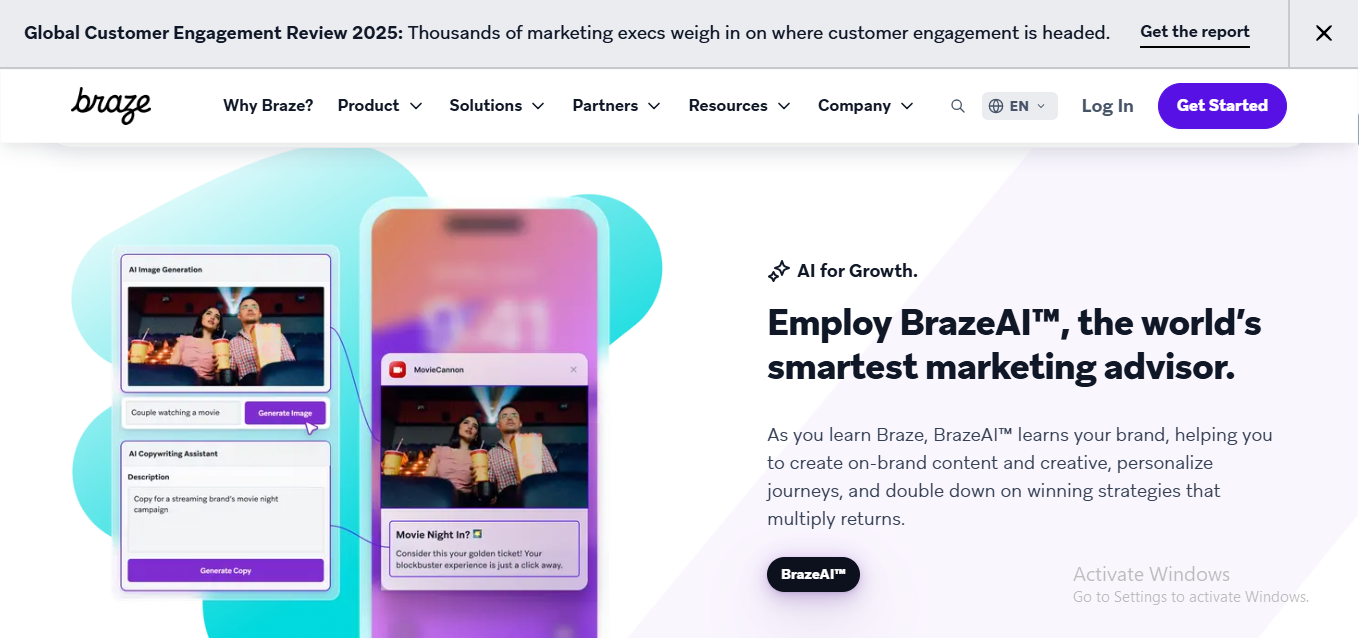
Okay, so Braze isn’t just an influencer platform—it’s more like a full-blown customer engagement suite. Think email, in-app messages, push notifications, and yes, influencer-style personalization.
What I Liked
-
Super data-driven. You can build these dope customer journeys that actually feel personal.
-
Integrates with all the big dogs (Shopify, Segment, etc.)
-
Helps you track user behavior and layer in creator content for a full-circle strategy.
What I Didn’t Love
-
Not really built just for influencer marketing—kinda overkill if that’s all you need.
-
Pricey af for small teams.
Pricing
Enterprise pricing. Translation: if you gotta ask, it’s probably expensive 💸
Best For: Bigger brands or SaaS companies who want to build journeys that include influencer-powered messaging.
15. IZEA
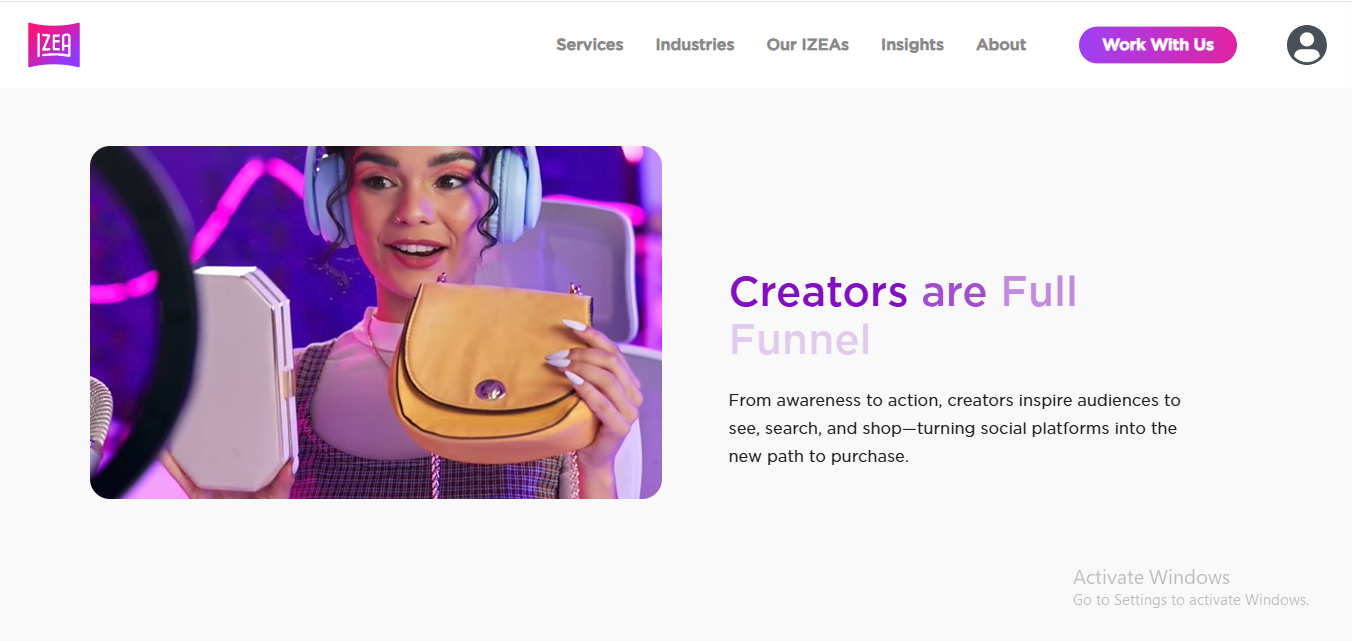
Ah yes, IZEA—the OG player that’s been in the influencer game since MySpace (okay not that far back, but close).
What I Liked
-
End-to-end workflow. Discovery, campaign management, payments—one stop shop.
-
Their influencer database is massive. I’m talkin’ millions of creators.
-
Great if you want to manage sponsored content and create custom content campaigns.
What I Didn’t Love
-
UI is a little dated—it works, but it’s not winning any beauty contests.
-
Pricing tiers can get confusing unless you know exactly what you need.
Pricing
Starts at around $500/month for access to the marketplace. Full suite features can climb above $5K/month.
Best For: Agencies or enterprise brands managing a lot of campaigns.
16. Insense

Insense is like if Fiverr and TikTok had a very creative baby. It’s heavily focused on UGC, especially for performance marketing (think TikTok ads and Reels).
What I Liked
-
You can find creators who specialize in ad-style content, not just influencers.
-
Seamless integration with Meta Ads Manager 👀 Huge win for paid social folks.
-
The campaign builder is straightforward, and creators are generally fast and responsive.
What I Didn’t Love
-
Less of a traditional influencer marketplace—more UGC-focused.
-
Needs better filtering options when searching for creators.
Pricing
Starts at $100/month, but expect to pay per creator and project. Good value for high-volume UGC.
Best For: DTC brands who want scroll-stopping TikTok and Reels-style content.
17. Influence.co
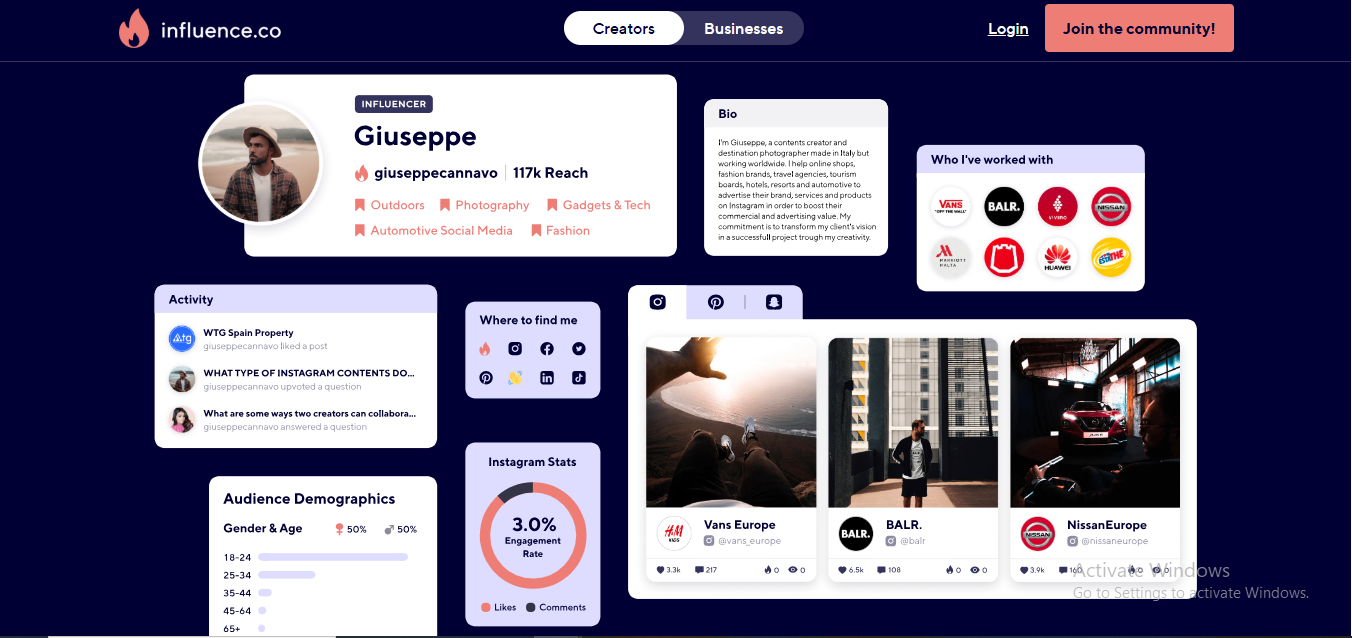
This one has serious “creator LinkedIn” energy—and I kinda dig it. It’s not just a platform for managing campaigns; it’s a community of influencers, marketers, and content creators.
What I Liked
-
Feels like a social network—great for organic collabs and building long-term relationships.
-
Built-in CRM and campaign tools.
-
Free option to get started and browse creators
What I Didn’t Love
-
Smaller creator pool compared to giants like IZEA or Aspire.
-
Some features (like analytics) feel pretty basic unless you’re on a paid plan.
Pricing
Free to start. Paid plans start at $24/month for pro features, scaling up depending on your usage.
Best For: Startups, solo marketers, or anyone wanting to vibe with creators before launching a big campaign.
18. Influencer.com
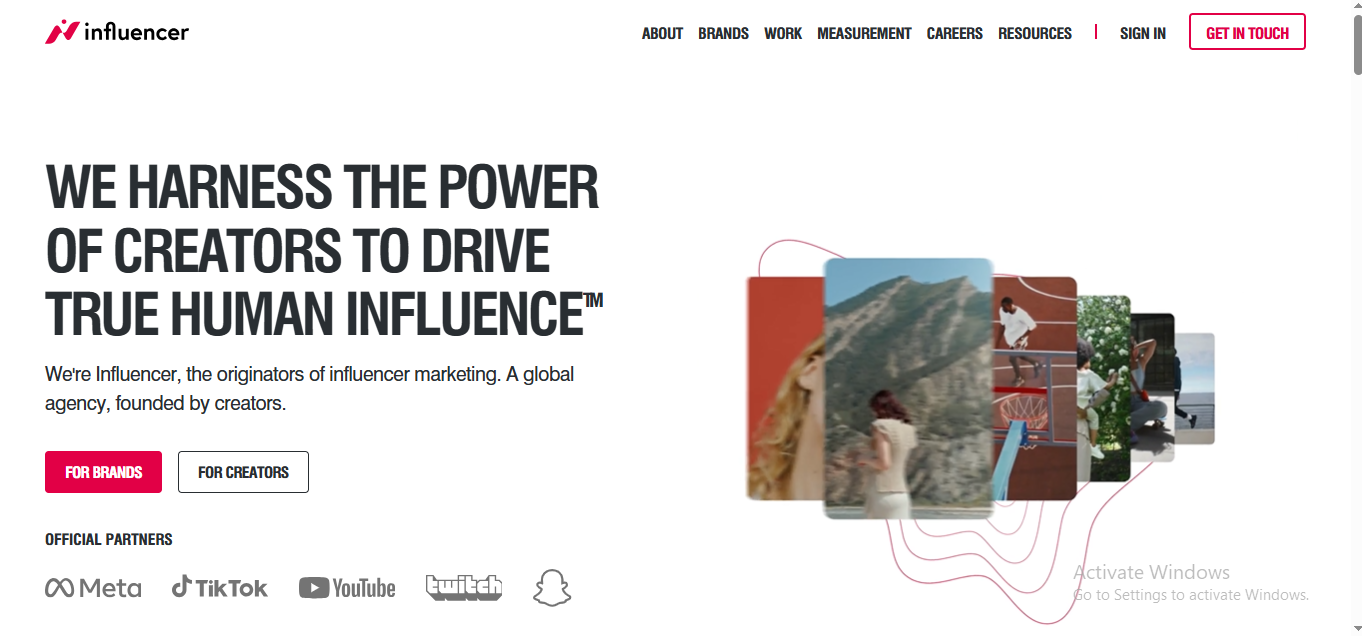
Okay, Influencer.com is for the serious players. It’s very campaign-focused, and they’ve got a rep for managing big-time launches with tight control over creative and data.
What I Liked
-
They’ve worked with legit brands like Google, Deliveroo, and Uber Eats. Like, this ain’t amateur hour.
-
Fantastic tools for tracking ROI, reach, and creative performance.
-
Managed service or self-serve depending on how hands-on you wanna be.
What I Didn’t Love
-
Definitely not a plug-and-play tool for casual users.
-
Pricing is… intimidating. You’re paying for a premium experience, no doubt.
Pricing
Fully custom. Usually for medium to large brands. Think agency-tier budgets.
Best For: Enterprise brands or campaign managers who want full control with data-backed decision-making.
19. Later
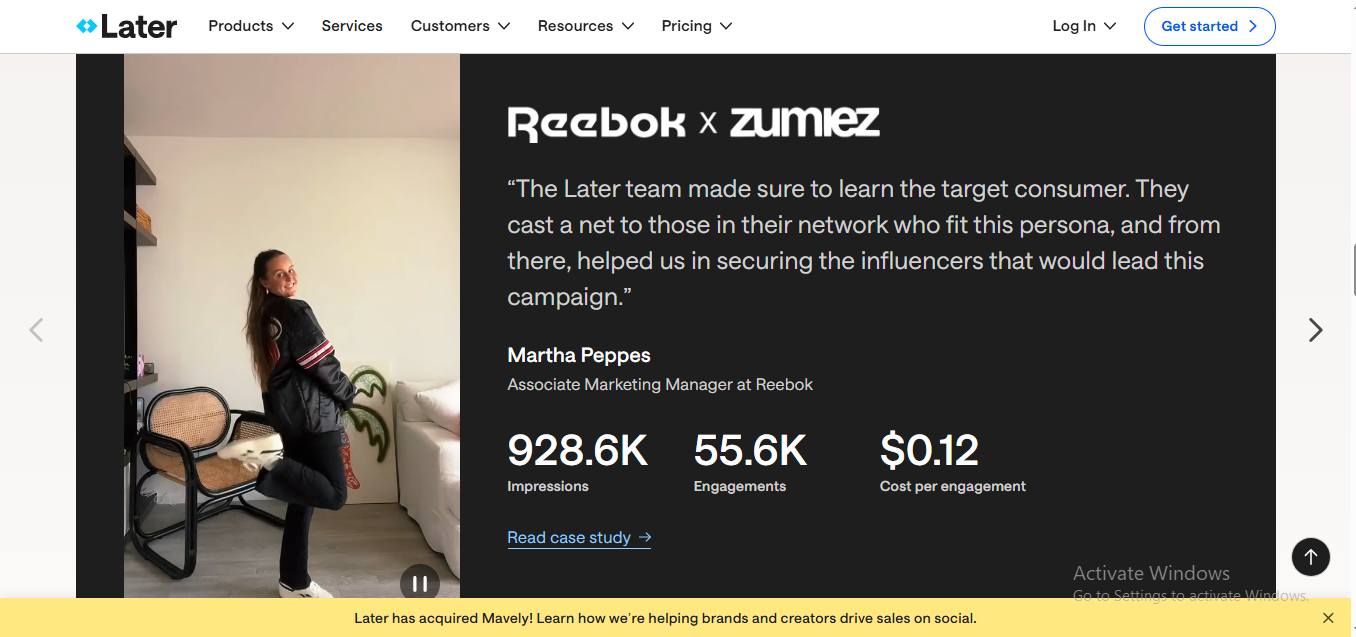
My Take:
Later isn’t just a scheduling tool anymore, fam. It’s turned into this dope all-in-one influencer management system. Think of it like the Beyoncé of Instagram planning—flawless and always trending.
What I Loved:
-
That Linkin.bio feature is a freakin’ game changer.
-
Built-in UGC content collection is smooth af.
-
Analytics are super digestible—great for when your brain’s running on iced coffee.
What Bugged Me:
-
The influencer database isn’t as deep as some of the bigger guys.
-
It can get pricey if you scale teams or need more users.
Pricing:
Starts free-ish but climbs fast—pro plans hover around $18/mo and beyond.
Best For:
Small-to-mid brands and creators who wanna streamline content + influencer management.
20. ShoutAgency
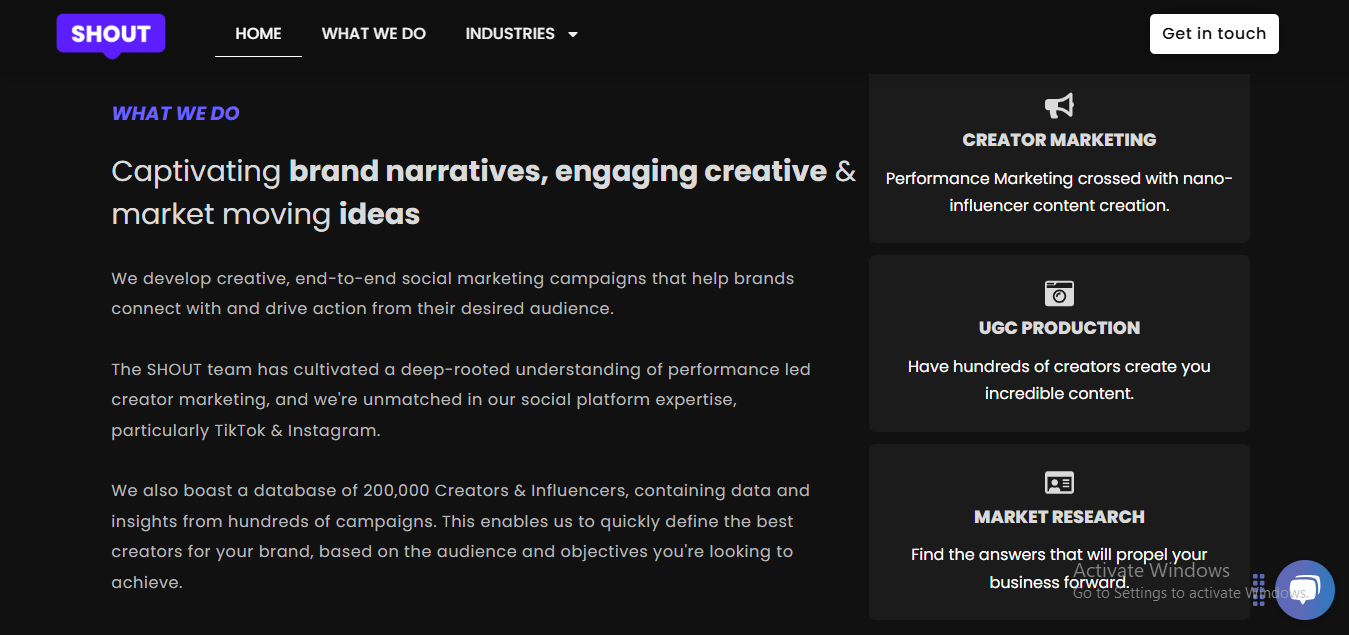
My Take:
ShoutAgency feels like that cool friend who just “gets” you. Their approach is community-driven, and they’re all about connecting real voices with real brands. No robotic influencers here.
What I Loved:
-
Strong focus on authenticity—which we love in this fake-filter world.
-
You can build long-term ambassador-type relationships.
-
Smooth onboarding and support was on point.
What Bugged Me:
-
The UI needs a little 2025 glow-up—it feels early 2020s.
-
Not as feature-heavy on analytics as I wanted.
Pricing:
Custom quotes—translation: you gotta talk to sales.
Best For:
Brands chasing niche, community-first vibes and organic collabs.
21. Klear
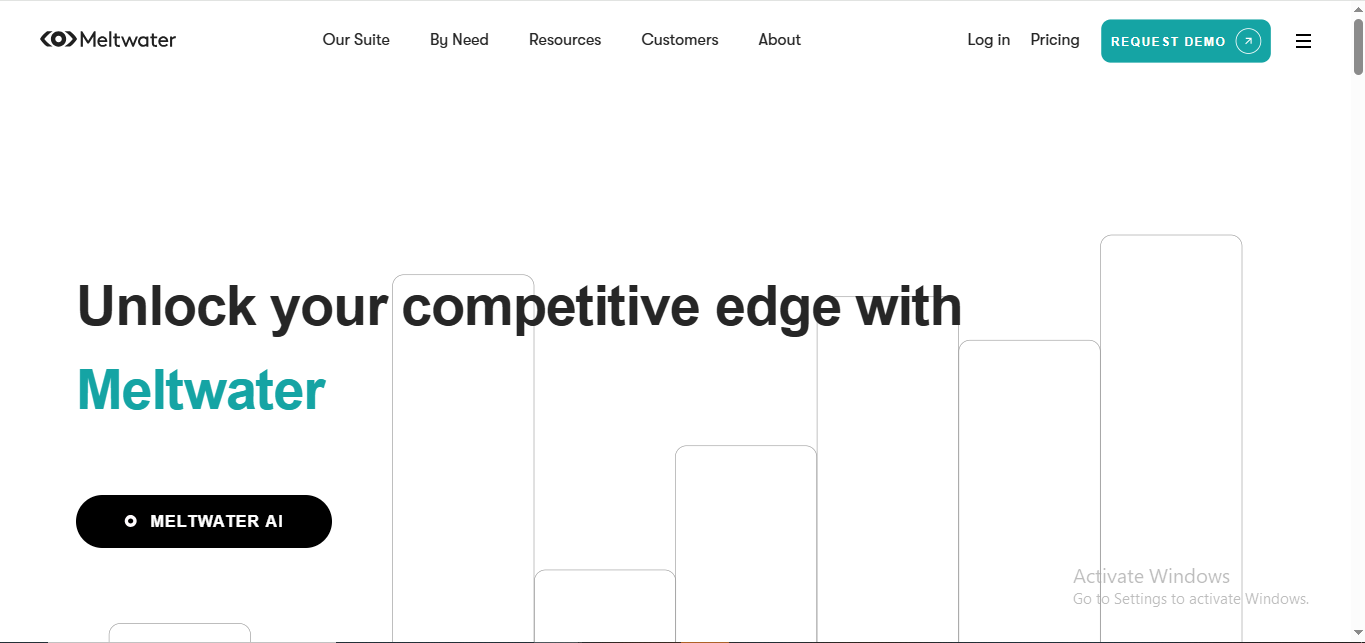
My Take:
Klear is like the Hermione Granger of influencer platforms—hella smart, organized, and always 10 steps ahead. It’s stacked with analytics, influencer discovery, and campaign management tools.
What I Loved:
-
Influencer search is A+—I legit found micro and nano creators in weird niches.
-
Amazing for data-driven marketers who geek out on metrics.
-
Social listening tool is top tier.
What Bugged Me:
-
It’s not for the faint of budget—pricey af.
-
Slightly overwhelming for first-timers. You might need a coffee and a tutorial.
Pricing:
Enterprise-level, so yeah… not for the side hustle budget.
Best For:
Big brands or agencies needing super detailed data and tracking across multiple channels.
22. Brandbassador

My Take:
This one gave major squad goals energy. Brandbassador is all about turning your customers into influencers and gamifying the heck outta brand love.
What I Loved:
-
The missions system is wild—it’s like influencer quests. Kinda fun, ngl.
-
Built-in affiliate tracking is seamless.
-
Great for DTC brands wanting loyal evangelists vs one-time posts.
What Bugged Me:
-
Not ideal for traditional influencer outreach—it’s more about brand community.
-
Some onboarding learning curves with all the features.
Pricing:
Mid-tier to enterprise. Custom pricing, so it really depends on your size.
Best For:
Ecom brands building tribe-like communities and driving repeat advocacy.
23. Shout UGC
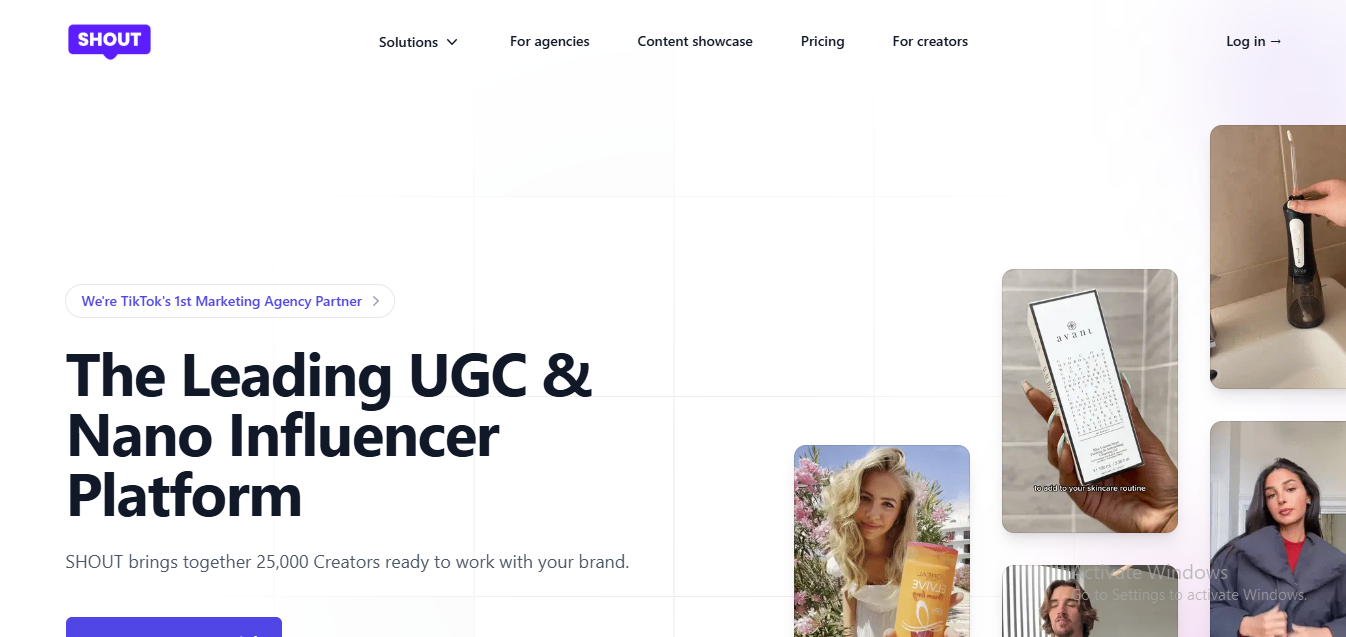
My Take:
Shout UGC is like the chill cousin of ShoutAgency—leaner, but super focused on authentic user-generated content. It’s basically built for brands that want content that doesn’t scream “sponsored.”
What I Loved:
-
Super easy to use. No fluff.
-
Great UGC sourcing—the creators feel real, not staged.
-
Fast turnaround on deliverables.
What Bugged Me:
-
Lacks in-depth campaign tracking.
-
You’ll need to combine it with other tools if you want full influencer mgmt.
Pricing:
Affordable—great for small brands or startups.
Best For:
Brands that want genuine UGC without all the influencer contract drama.
24. CreatorIQ
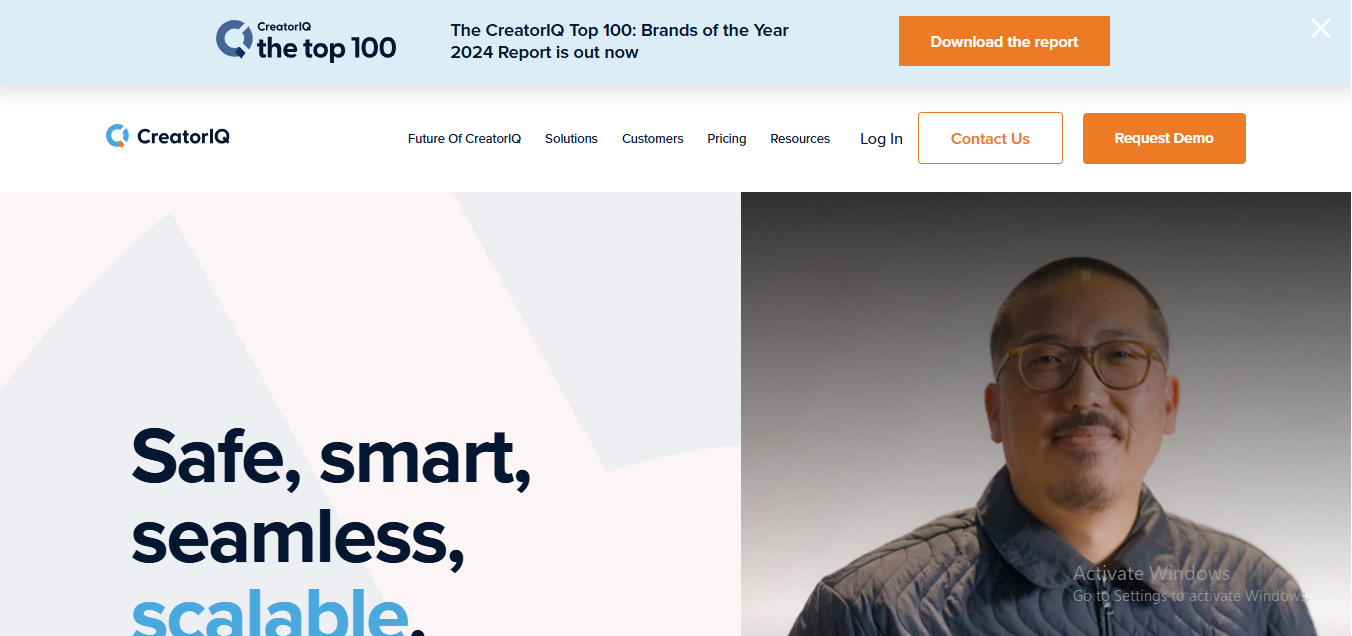
My Take:
CreatorIQ is that Ivy League influencer platform. It’s sleek, powerful, and built for brands running serious campaigns. Definitely not your casual Saturday scroll type of tool.
What I Loved:
-
Probably the best reporting suite in this list.
-
Real-time campaign management + fraud detection.
-
Epic for cross-channel influencer work—YouTube, TikTok, Insta, all that jazz.
What Bugged Me:
-
Pricey and complicated for smaller teams.
-
Onboarding felt like a college course (but like… an expensive one).
Pricing:
Enterprise-only. If you have to ask, you probably can’t afford it
Best For:
Agencies, global brands, and companies running influencer campaigns like an orchestra.
25. InfluencerMarketing.ai
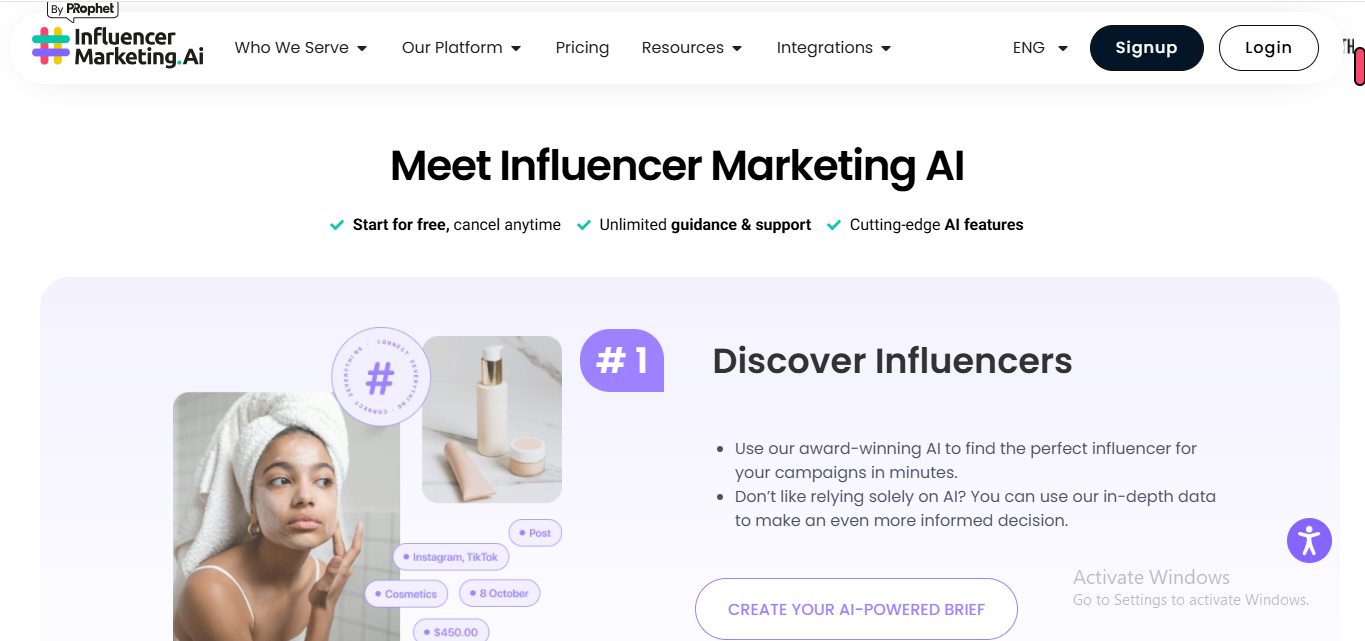
My Take:
This one was a low-key surprise. It might not be the biggest name in the game (yet), but InfluencerMarketing.ai came through with some solid AI muscle. If you’re into automating everything but still want that human touch—this is your jam.
What I Loved:
-
AI-driven influencer matching—like dating apps, but for your brand collabs.
-
You can filter creators based on tons of data (engagement, audience type, location, vibes, etc.).
-
Real-time performance tracking = clutch for mid-campaign adjustments.
What Bugged Me:
-
UX felt a bit overwhelming at first—too many tabs, too little chill.
-
Doesn’t have the biggest influencer pool compared to the OGs.
Pricing:
Starts budget-friendly but scales up quick once you need the good stuff.
Best For:
Startups and agencies who love data, want AI tools, but still need a little hand-holding.
26. Traackr

My Take:
Traackr = the professor of influencer marketing. Like, this tool is all business, no fluff. Definitely not for IG-famous cat meme brands. It’s made for teams who need deep insights, complex campaigns, and global reach.
What I Loved:
-
Top-tier influencer analytics—demographics, audience quality, brand affinity, you name it.
-
Killer ROI tracking with dollar values you can actually present to the big bosses.
-
Massive global influencer coverage.
What Bugged Me:
-
Not cute. The dashboard is functional but def not TikTok-pretty.
-
Feels super corporate, which can be intimidating if you’re just getting started.
Pricing:
Enterprise-level stuff, so yeah… pricey. You’ll need a budget (and a pitch deck, lol).
Best For:
Global brands and enterprise marketers who need solid metrics and multi-market insights.
27. Upfluence
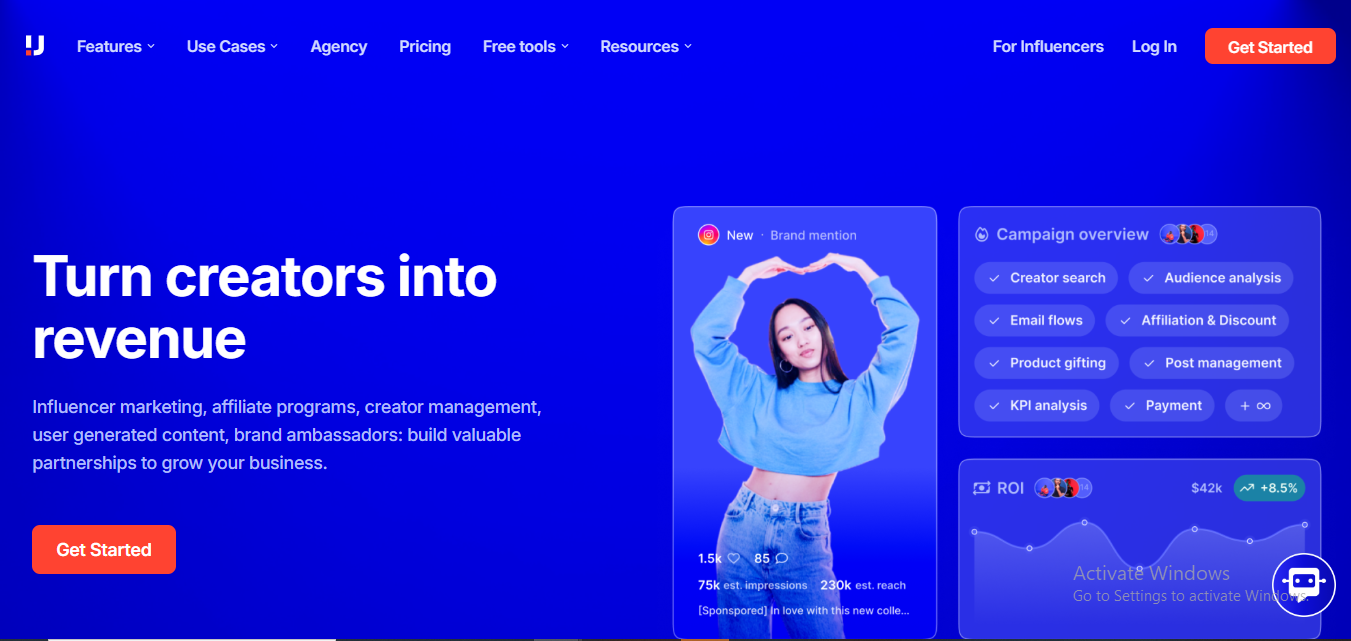
My Take:
Upfluence is like that influencer friend who’s organized, charismatic, and lowkey a control freak (in the best way). It’s an all-in-one system that makes discovery, outreach, payments, and tracking feel like a walk in the park.
What I Loved:
-
Search engine for influencers is smooth af. Filters galore.
-
You can turn your existing customers into influencers (hello, CRM sync!)
-
Workflow automation actually works—no random crashes.
What Bugged Me:
-
Can get expensive fast depending on usage volume.
-
Some reporting features are hidden in weird places (like an influencer’s Finsta account).
Pricing:
Flexible but not cheap. Great ROI if you’re doing frequent campaigns.
Best For:
Mid-to-large teams looking to manage everything in one platform, from start to send.
28. Meltwater (Influencer Edition)

My Take:
So Meltwater isn’t just for PR peeps anymore. They’ve expanded into the influencer world with tools that are honestly slept on. Think of it as the LinkedIn-meets-CNN of influencer campaigns. All business, but with a side of content swag.
What I Loved:
-
Social listening is chef’s kiss—you can see what people are saying about you everywhere.
-
Love that they combine PR, marketing, and influencer analytics in one.
-
Super detailed campaign reporting, which is perf for boardroom slides.
What Bugged Me:
-
Not intuitive. You WILL need a demo or two to wrap your head around it.
-
Definitely not creator-focused—it’s for the suits.
Pricing:
Enterprise-level. They ain’t listing it on the website for a reason, ya feel?
Best For:
Big brands and agencies doing integrated PR + influencer + media strategy.
29. The Social Cat

My Take:
This one was such a vibe! The Social Cat is small but mighty. It flips the script by making creators pitch you, not the other way around. I was like—okay queen, flip the power dynamic 👏
What I Loved:
-
UGC-focused and built for small businesses.
-
Micro and nano-influencers with solid engagement—not just pretty numbers.
-
Crazy fast turnaround—like same-day intros sometimes.
What Bugged Me:
-
Database is still growing, so limited reach outside certain niches.
-
Some creators need coaching—they’re not always pros yet.
Pricing:
Super affordable. Monthly plans under $100. Wild.
Best For:
Startups, ecom brands, and anyone wanting genuine UGC without breaking the bank.
- Best Datanyze Alternatives for 2025 - April 24, 2025
- Best Hunter.io Alternatives for 2025 - April 22, 2025
- Best Lead411 Alternatives for 2025 - April 22, 2025

